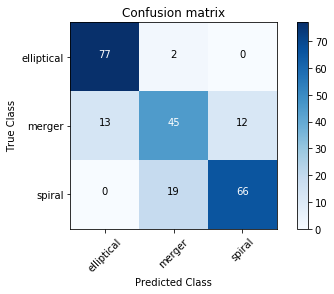Ecosyste.ms: Awesome
An open API service indexing awesome lists of open source software.
https://github.com/ChaoticBlack/galaxy-classification-ml
Classifying galaxies using various machine learning models
https://github.com/ChaoticBlack/galaxy-classification-ml
astronomy classification machine-learning
Last synced: 8 days ago
JSON representation
Classifying galaxies using various machine learning models
- Host: GitHub
- URL: https://github.com/ChaoticBlack/galaxy-classification-ml
- Owner: ChaoticBlack
- Created: 2020-05-22T06:08:56.000Z (over 4 years ago)
- Default Branch: master
- Last Pushed: 2020-06-16T12:22:08.000Z (over 4 years ago)
- Last Synced: 2024-08-02T15:06:10.050Z (3 months ago)
- Topics: astronomy, classification, machine-learning
- Language: Jupyter Notebook
- Size: 2.88 MB
- Stars: 2
- Watchers: 1
- Forks: 2
- Open Issues: 1
-
Metadata Files:
- Readme: README.md
- Support: support_functions.py
Awesome Lists containing this project
README
# galaxy-classification-ml
Classifying galaxies using various machine learning models into 3 categories(merger,elliptical,spiral)
# Prerequisites
* Python 3.6+
* Jupyter Notebook
Libraries
* scikit-learn
* numpy
* matplotlib
* dtreeplt
# Galaxy Zoo Data

[Galaxy Zoo](https://www.zooniverse.org/projects/zookeeper/galaxy-zoo/) is a crowdsourced astronomy project which invites people to assist in the morphological classification of large numbers of galaxies. For this project, I limited the data to only 3 types of galaxies.
The data set is a numpy array containing features and classification of 780 galaxies. This dataset is a sample of galaxies where at least 20 human classifiers (volunteers) have come to a consensus on the galaxy type.
Hence, this is a high quality dataset
## Features
The features that I have used to do the galaxy classification are colour index, adaptive moments, eccentricities and concentrations. These features are provided as part of the SDSS catalogue.
**Colour indices** are the colour (u-g, g-r, r-i, and i-z) filters from SDSS. Studies of galaxy evolution tell us that spiral galaxies have younger star populations and therefore are 'bluer' (brighter at lower wavelengths). Elliptical galaxies have an older star population and are brighter at higher wavelengths ('redder').

**Eccentricity** approximates the shape of the galaxy by fitting an ellipse to its profile. Eccentricity is the ratio of the two axis (semi-major and semi-minor). The De Vaucouleurs model was used to attain these two axis. To simplify the experiment, I used the median eccentricity across the 5 filters.

**Adaptive moments** also describe the shape of a galaxy. They are used in image analysis to detect similar objects at different sizes and orientations. I used the fourth moment here for each band.
**Concentration** is similar to the luminosity profile of the galaxy, which measures what proportion of a galaxy's total light is emitted within what radius. A simplified way to represent this is to take the ratio of the radii containing 50% and 90% of the Petrosian flux.
The Petrosian method allows to compare the radial profiles of galaxies at different distances. If you are interested, you can [read more here](http://spiff.rit.edu/classes/phys443/lectures/gal_1/petro/petro.html) on the need for Petrosian approach.
For these experiments, I will define concentration as: conc = petro R50/petro R90 , using concentrations from u,r and z bands.

## Accuracy Score
**Decision Tree Accuracy:** 0.787179487179
**Random Forest Accuracy:** 0.873076923077
**Neural Network Classification Accuracy:** 0.8760683760683761
**Confusion matrix**


## Acknowlegments
* Galaxy Zoo
* [Data Driven Astronomy Course](https://www.coursera.org/learn/data-driven-astronomy) offered by the University of Sydney